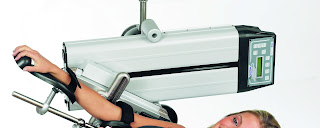The fracture of humerus's head
Post-operative protocol with Fisiotek HP2
This rehabilitative protocol for the fracture of humerus's head is part of a clinical study made by Prof. Carlo Mammarella and C. Sarti, from A.S.L. S. Camillo - Forlanini in Rome (Italy), who they have analysed the clinical evidences and the rehabilitative value of Fisiotek HP2 for the rehabilitation of surgical pathologies of the shoulder.
The case study has been based on 16 cases (10 women and 6 men), with an average of age aroung 54 years: these cases have been divided in two groups of 8 people each, the first one treated with Fisiotek HP2 and the other one treated with the classic mobilization.
GROUP A --> treatment with Fisiotek HP2
GROUP B --> treatment with classic mobilization
For the first 7 days after the intervention, all the people have worn a shoulder brace, in spite of the therapy which has started 9 days after the intervention.
As datas of reference for shoulder's mobility, it has been taken ROM values of Kapandji:
Movement
|
ROM
|
Abduction
|
0° à
180°
|
Flexion
|
0° à
180°
|
Extension
|
0° à
50°
|
External Rotation
|
0° à
80°
|
Internal Rotation
|
0° à
110°
|
Initially, at the beginning of the treatment, it has been observed these values of ROM:
Abduction: 0° to 15°
Flexion: 20°
Extension: 20°
Rotation: 0°
People of the group A, have been treated in seated position (on bed and on a chair), apart from 4 people with multi-fractures, who have been rehabilitated in supine position.
People from group B have been treated by the physiotherapist in sessions of 15 minutes each one.
Here below in the chart is explained the rehabilitative program carried out for Group A:
Period
|
Treatment – modalities –
timetables – R.O.M.
|
From 9th to 15th day
|
2 sessions per day
(40 min. each) ;
ROM: abduction 0°
-> 40° / flexion 0° -> 30° / extension 0° -> 10°
|
From 15th to 25th day
|
2 sessions per day
(60 min. each) ;
Increase of the ROM
of 10° every 4 days ;
Beginning of active
mobilization assisted;
|
From 25th to 45th day
|
Addition of internal
rotation ( 0° -> 30°) and external rotation (0° -> 40°) ;
Increase of the ROM
of 10° every 5 days ;
|
Over 45th day
|
Second phase of the
protocol: active exercises, resistance, stretching;
|
As results of this study, we summarize them in the chart:
Movement
|
Group
|
Periods and R.O.M. reached
|
||
Adduction
|
15 days
|
30 days
|
45 days
|
|
Group A
|
70°
|
110°
|
140°
|
|
Group B
|
50°
|
70°
|
90°
|
|
Flexion – Extension
|
15 days
|
30 days
|
45 days
|
|
Group A
|
30°-20°
|
90°-30°
|
110°-40°
|
|
Group B
|
20°-10°
|
60°-20°
|
80°-30°
|
|
Internal – External rotation
|
15 days
|
30 days
|
45 days
|
|
Group A
|
15°-20°
|
30°-40°
|
45°-55°
|
|
Group B
|
10°-15°
|
20°-30°
|
40°-35°
|
|
Surely after a first view of the chart, is easy to say that passive mobilization with a CPM device can accellerate all the rehabilitation program.
In particular, we can have a rapid recovery of the articular range and a better result in terms of R.O.M. reached: in addition, a better functional recovery and the acceleration of the following phases of the protocol.
In conclusion, compared with the classic methodology, passive rehabilitation with Fisiotek HP2 provide less anxiety and stress to the patient, who's more relaxed: this point is appreciated because patient feels without fears.





